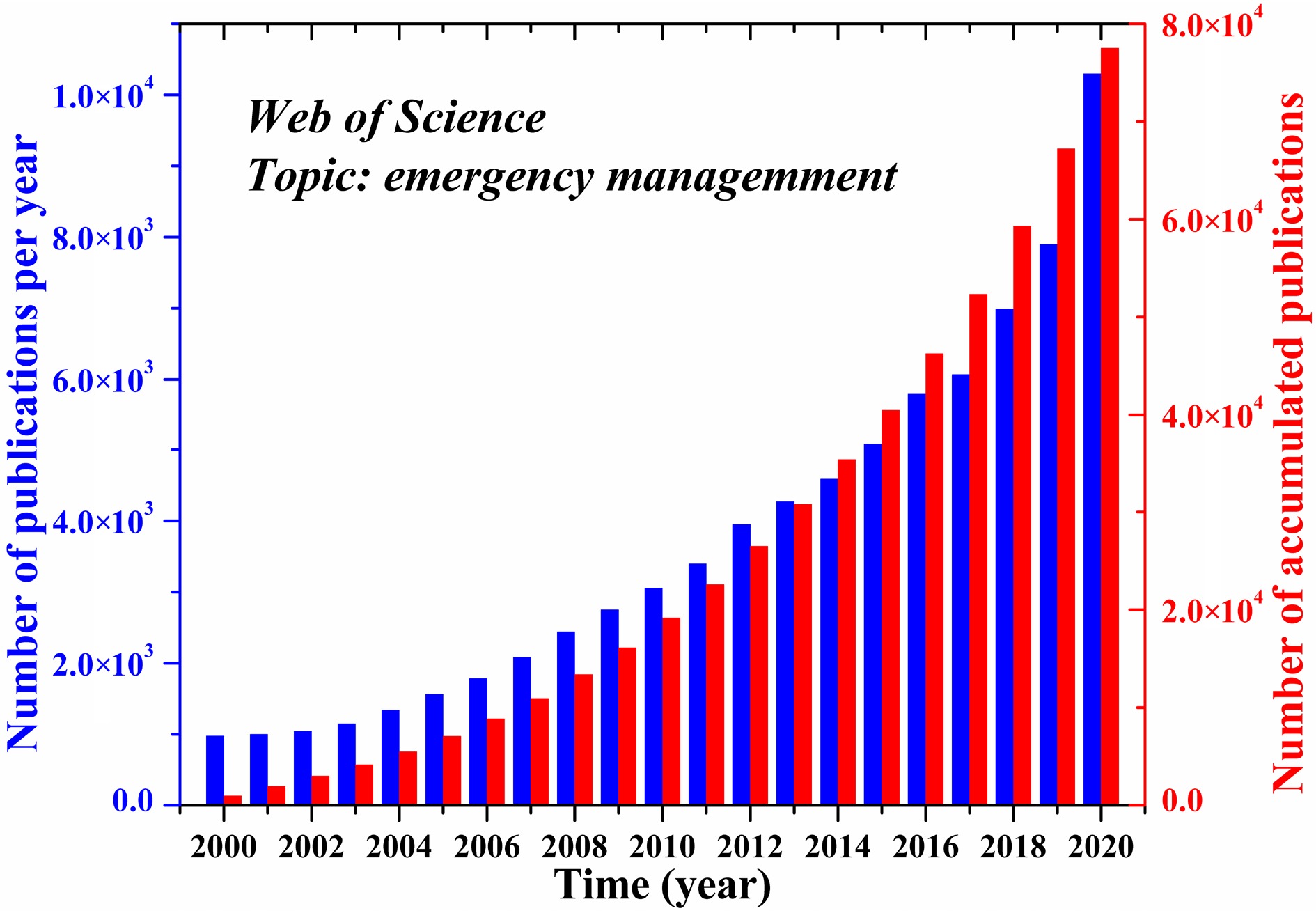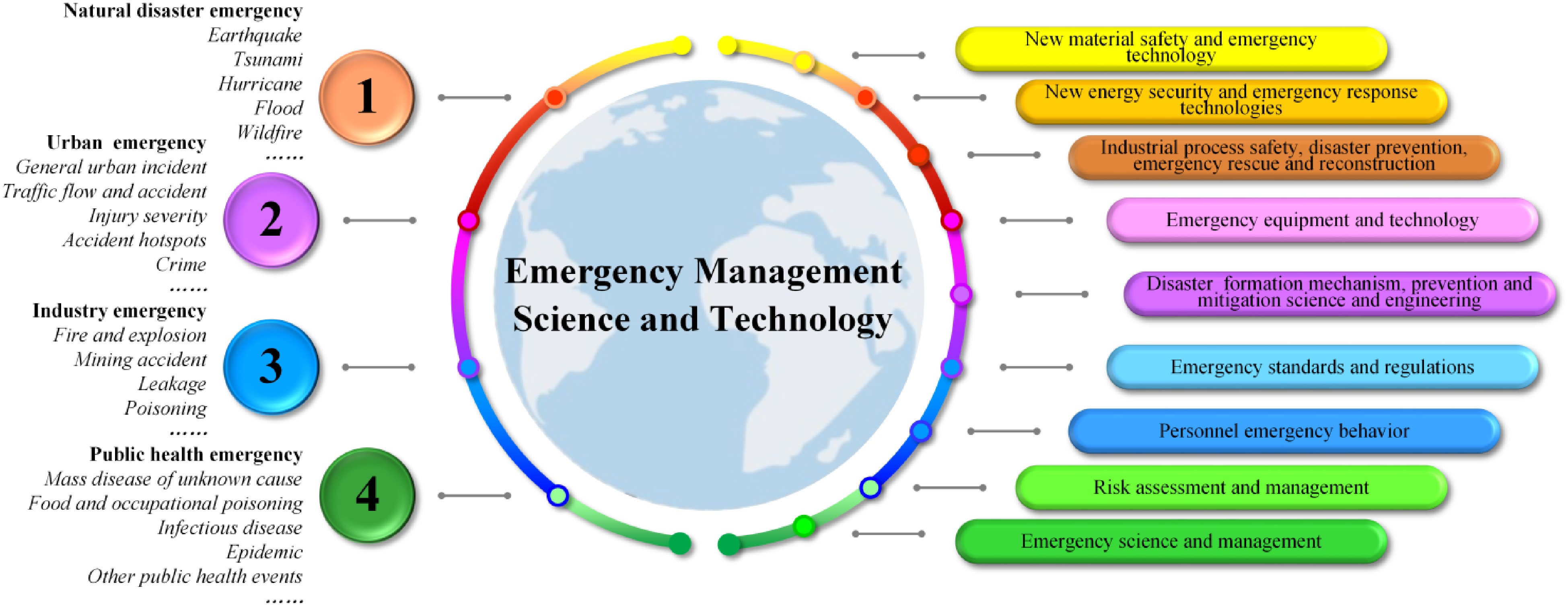-
Clear evidence indicates that the earth is experiencing a gradual increase in global average temperature, which is deemed to contribute considerably to the frequent occurrence of extreme natural events, including droughts, flooding, hurricanes, storm surges, wildfires, desertification, sandstorms, landslides, debris flows, plague, and crop biological disasters. Additionally, human-related or technological disasters, such as industrial and transportation accidents, further facilitate the risk of human exposure to extreme urban hazards, and cause high casualties, fatalities and financial losses. These worldwide natural disasters and tremendous production safety accidents have had a huge negative impact on human life and posed devastating threats to social stability. The last few decades have witnessed a dramatic increase in disastrous events. Over the past decade, more than 7,300 disastrous events were reported worldwide, an increase of 73% compared to those reported between 1980 and 1999[1]. In order to improve the response capability and minimize property damage when encountering various types of disasters, emergency management (EM) systems have been established rapidly in most countries and regions. The development of timely and effective EM systems has become increasingly attractive, primarily aiming to help and enable emergency managers to prepare for unanticipated disasters and respond to urgent events. The definition of EM is given as an integrated decision support system composed of a variety of tasks that covers the lifecycle of an emergency event[2]. Effective prevention of emergency events serves as a key role in EM systems aimed at minimizing or eliminating losses and impacts in advance.
Historically, evolution of EM has seen four main stages of development:
1. 1993−2003. International EM was focused on five main aspects: disasters, emergency-management, hurricanes, resilience, and decision-support-systems. The scale of each category is smaller than the ones seen in later systems, representing the status of the initial phase of EM development.
2. 2004−2008. International EM consisted of seven main aspects: disasters, earthquake, emergency, emergency-management, hazard-assessment, hurricanes, and risk-assessment. This stage took on the themes of the previous stage and added two additional aspects involving earthquake and risk assessment.
3. 2009−2013. International EM investigation further expanded the field to 15 aspects: algorithm, cardiac-arrest, decision-support-systems, disasters, earthquake, emergency, emergency-departments, emergency-management, evacuation, hurricanes, modeling, post-disaster-recovery, resilience, risk-communication, and tsunami. This stage drastically enriched the connotation of EM by developing the themes of algorithm, cardiac-arrest, emergency-departments, evacuation, modeling, post-disaster-recovery, and risk-communication. The emphases in this stage changed from disaster management and qualitative assessment to quantitative analytical modelling, evaluation and post-disaster response. In particular, relevant research on medical emergency management was also merged into this stage.
4. 2014−2021. International EM continued to increase its content to include 24 aspects: collaboration, community, coordination, decision-support-systems, disasters, earthquake, emergency, emergency management, evacuation, extreme-heat-events, flooding, flood risk, guidelines, local government, optimization, resilience, response, risk, risk-communication, simulation, storm-surge, tornadoes, etc. The themes in this stage featured some new characteristics, to cooperate or collaborate, which served as an efficient path for enabling optical allocation of resources across institutions and improvement of EM efficiency, and was given key importance in EM system development.
With unlimited potential in fundamental research, comprehensive practical applications, and ever-increasing funding from governments, industries, and government/industry consortia around the world, EM is growing into an emerging interdisciplinary field. This field integrates a wide range of research areas, including economics, sociology, law, psychology, environmental science, biology, physics, chemistry, astronomy, atmospheric science, ocean science, geophysics, geology, system science, mechanical engineering, materials science and engineering, metallurgical engineering, engineering thermophysics, electrical engineering, electronic science, information and communication engineering, control science and engineering, computer science, architecture, civil engineering, water conservancy engineering, mining engineering, transportation engineering, medicine, and management. The fact that EM has drawn increased attention has accelerated its evolution, as shown by the rapid increase in publications related to EM per year, which has seen a particularly dramatic increase in the last decade (Fig. 1). The general framework of EM systems consists of a series of decision-making issues belonging to three phases: (i) pre-event forecasting and preparation; (ii) in-event response and evacuation; and (iii) post-event recovery[3]. By analyzing historically similar events or scenarios, the current modern intelligence EM systems emphasize the importance of learning from previous experience when a new emergency event occurs[4]. All types of state-of-the-art techniques can be applied at each stage to gather, process, and update spatial, transient, and environmental information during emergency events. These techniques include Remote Sensing (RS)[5], Geography Information Systems (GIS)[6], and Global Positioning Systems (GPS)[7], Artificial Intelligence (AI)[4], Internet of Things (IoT)[8,9], big data analytics[10], and data mining[11].

Figure 1. Number of publications per year (left axis) and accumulated publications (right axis) related to emergency management in Web of Science (https://www.webofscience.com/wos/woscc/summary/74f9b74f-a8a9-43b4-94f0-66c91ed58f2b-12a9adb7/relevance/1).
To support the promising and fast growing area of EM research, we are launching the Journal of Emergency Management Science and Technology, dedicated to both fundamental and applied research, to foster multidisciplinary collaboration, and promote dissemination of scientific information and knowledge in the field of EM. As a rigorously peer-reviewed and open access online journal, it is devoted to timely, efficient, and global dissemination of scientific discoveries, technological progress, and social responsibilities in the field of EM research. Its contributors and audience will range from social scientists to engineers concerned with natural disasters, urban emergency, highway and logistics and public health emergencies (Fig. 2). It will publish high-quality original research papers, review articles, case studies, short communications, editorials, letters, and perspectives from a wide variety of sources dealing with all aspects of the science and technology of emergency, including: new material safety and emergency technology; new energy security and emergency response technologies; industrial process safety; industrial disaster prevention, emergency rescue and reconstruction; emergency equipment and technology; disaster prevention and mitigation science and engineering; emergency standards and regulations; personnel emergency behavior; risk assessment and management; emergency science and management (Fig. 2). We are honored to serve the EM community as the editor-in-chief and executive editor and sincerely appreciate the highly prestigious experts who serve as associate editors. With the generous help and collective efforts from the editorial board, authors, reviewers, and readers, we hope that this journal will grow rapidly to become a leading journal in the field of EM.
HTML
- The writing of this manuscript was supported by The College of Emergency Management Science and Technology, The College of Safety Science and Engineering, The College of Chemical Engineering, The School of Mechanical and Power Engineering, The College of Law and Political Science, and The College of Transportation Engineering at Nanjing Technology.
- The authors declare that they have no conflict of interest.
- Copyright: © 2021 by the author(s). Exclusive Licensee Maximum Academic Press, Fayetteville, GA. This article is an open access article distributed under Creative Commons Attribution License (CC BY 4.0), visit https://creativecommons.org/licenses/by/4.0/.
|
|














